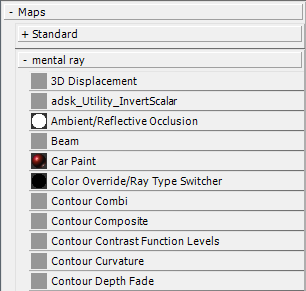In mental ray, a shader is a function that calculates light effects. There can be shaders for lights, cameras (lens shaders), materials, shadows, and so on.
The mental ray renderer can render most types of 3ds Max materials and maps. See 3ds Max Materials in mental ray Renderings. In addition, if you have enabled mental ray extensions (see mental ray Preferences), you can apply a variety of shaders to materials. Materials designed for use with the mental ray renderer have specific components to which you can assign a shader. And for standard 3ds Max material types, the mental ray Connection rollout lets you add mental ray shading.
You use the Material/Map Browser to assign a mental ray shader the same way you do a map.

mental ray maps in the Browser list
 Camera Effects rollout, and the controls to assign light shaders are on a light object's mental ray Light Shader rollout. This rollout appears only on the Modify panel, not the Create panel.
Camera Effects rollout, and the controls to assign light shaders are on a light object's mental ray Light Shader rollout. This rollout appears only on the Modify panel, not the Create panel.
The shaders listed in the Browser come from several libraries that are provided with 3ds Max. Shaders created specifically for 3ds Max are described in this document. Shaders provided with the mental images or lume shader libraries have their own online documentation.
In addition to the shaders described in the topics that follow, 3ds Max includes these shaders:
mental ray Shaders not Provided with 3ds Max
If your installation includes shader libraries other than those listed in this reference (whether obtained from a third-party source, or custom written), then the Browser might list those shaders as well. Documentation for third-party or custom shaders should come from the shader's provider.
Shaders provided with 3ds Max are installed in the subdirectory \mentalimages\shaders_standard\, below the 3ds Max root directory. The \include folder is for the MI include files, and the \shaders folder is for the DLLs.
Third-party shaders should not be installed in \shaders_standard. They should be installed either in \shaders_3rdparty or \shaders_autoload. If a third-party shader is present in \shaders_autoload, it is loaded automatically when you start 3ds Max. If a third-party shader is present in \shaders_3rdparty, you must update the file 3rdparty.mi so it explicitly loads the shader. The MI file \shaders_3rdparty\3rdparty.mi contains comments that explain how to add load statements.
The shaders provided with standard libraries from mental images are meant for use with the mental ray renderer.
The LumeTools Collection of shaders provide a variety of naturalistic effects when used with the mental ray renderer. These are the Lume shaders provided with 3ds Max:
The topics in this section describe custom shaders for use with the mental ray renderer, and 3ds Max.
The Production Shaders category of advanced mental ray shaders comprises several texture shaders, a shader for black-body radiation, one for subdividing light by ray type, a lens shader, and two output shaders, all covered in this section. Also part of the Production Shaders library is the Matte/Shadow/Reflection material.